One of the things I found fascinating about Brussels on our recent holiday was – in contrast to Cardiff – how they’ve gone out of their way to make life easy for pedestrians.
Most striking was that there were zebra crossings. Lots and lots of zebra crossings.
When I first spotted how many there were, I wasn’t totally sure what I was seeing, and actually warned my fellow travellers to watch and observe the locals, just in case the road markings didn’t mean what they mean in Australia. Did vehicles really have to stop for pedestrians at all these locations?
Yes. The stripes mean the same thing (except if there are traffic lights). There are just lots of zebra crossings.
Zebra crossings on main streets, zebra crossings on minor streets, zebra crossings on divided roads with trams in the middle, zebra crossings at intersections and mid-block.
Lots and lots of zebra crossings, and drivers observed them – perhaps because they’re so used to them.
Roundabouts? Not a problem. In Australia, these are virtually the only locations where vehicles in any direction don’t have to give way. Exceptions are rare. The Belgian roundabouts I saw had zebra crossings on all sides:
Two T-junctions so close together that putting zebra crossings on every side would mean three in row? Sure, go ahead. The motorists will survive:
Generally, motor vehicles had to give way to pedestrians, but pedestrians had to give way to trams.
How much does having lots of zebra crossings affect traffic? It’s hard to say, but the cars driving around didn’t seem to be unduly held up. When I saw peak hour traffic set in, it was clear that – as anywhere else – the main thing delaying cars was other cars.
Some wider streets had traffic lights with pedestrian crossings. At many of these, you didn’t have to press a “beg” button – there was no button. The green man triggered automatically:
This not only tells pedestrians approaching that they don’t have to press a button to cross. It also indicates the authorities have no intention of changing it (and necessitating having a button) any time soon.
This of course is how it should be. If you’re giving the green to vehicles, why wouldn’t you also give the green to pedestrians? (More about this in another rant post soon.)
Note the signalised crossings have the same on-road markings as zebra crossings. I wonder if that helps with compliance? They’re much more obvious than the Australian dashed line markings.
At a few spots I saw, buttons were necessary to trigger the green man. These seemed to be reasonably responsive, not making you wait too long:
In some locations, presumably those that get very busy at times, the crossings were very wide.
Along with mostly wide footpaths (at least, wide enough to cope with pedestrian traffic), the design of the crossings left one with the impression that Belgian authorities would prefer you walked than drive.
It’s the sort of thing that some might not even notice, but it left an impression on me. If only Australian authorities were so inspired.
Could we do this in Australia?
Sure. But while some new zebra crossings have popped up over the last few years, they don’t seem to be routinely installed.
This spot outside Gardiner Station clearly should have been a zebra crossing:
And don't forget this gem down the street – FOUR signs just in case you forget who has priority after you cross over the tracks. pic.twitter.com/hNWaJIhbpS
— Alexa Delbosc (@AlexaDelbosc) September 12, 2017
This was almost a zebra crossing, but someone messed up. (I shouldn’t have opened my big mouth. It’s now entirely a signalised crossing… which thanks to the beg button, many people ignore):
Hey @MaribyrnongCC, is this meant to be a zebra crossing, or not? http://t.co/Kax8z2wULM pic.twitter.com/X0xPge8Scn
— Daniel Bowen (@danielbowen) May 18, 2014
This is the newish tram stop on Collins Street at William Street. It could have had zebra crossings at the non-intersection end. But someone decided a signalised crossing was a better idea. It’s maddeningly slow to wait for if you’re crossing, and many people just cross whenever there’s a gap in the traffic:
I would think there’s also scope to place zebra crossings on side streets at intersections, particularly in suburban shopping centres.
The law says a vehicle turning into the street gives way, but convention is often the opposite, with vehicles exiting the street often giving way instead.
And pedestrians sometimes wave stopped motorists on, when the motorist is doing the right thing and giving way. (Do me a favour: if you’re crossing and other people are too, don’t wave the car on. You might not be in any great hurry to get where you’re going, but you don’t speak for everybody else.)
Painting zebra crossings right across the side street would not just encourage walking, it would also help reduce the confusion over who’s meant to give way to whom, in what are typically high traffic (pedestrian and vehicle) areas.
Ditto car park entrances, where motorists entering and exiting are meant to give way to pedestrians.
More zebra crossings are perfectly possible. Here’s what they’ve done in Footscray. It was quiet when I took this photo, but often there are lots of pedestrians around. Somehow, the traffic still gets through:
Potentially two-lane main roads like Centre Road and McKinnon Road could have zebra crossings too. That would be bringing it up to Belgian standards, and would be in line with the Vicroads Smartroads strategy which says it’s meant to prioritise pedestrians and buses. What would be the effect on traffic? It would be interesting to see it modelled.
Ultimately, if we prefer people walk where possible, more needs to be done to encourage it.
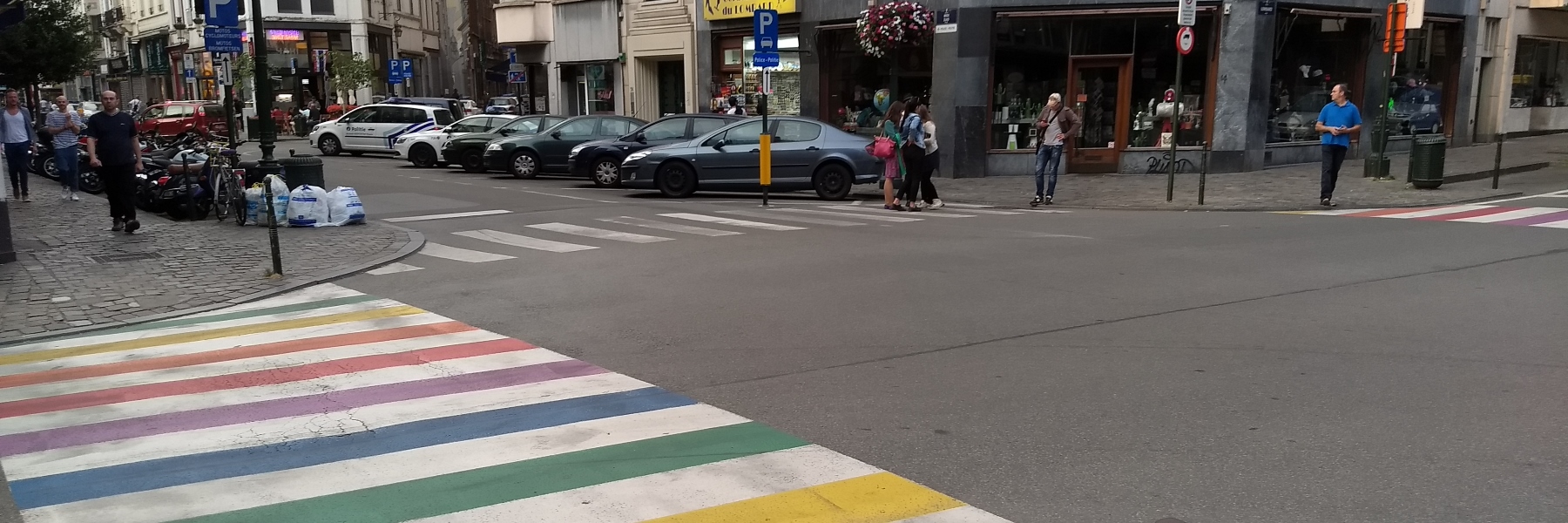
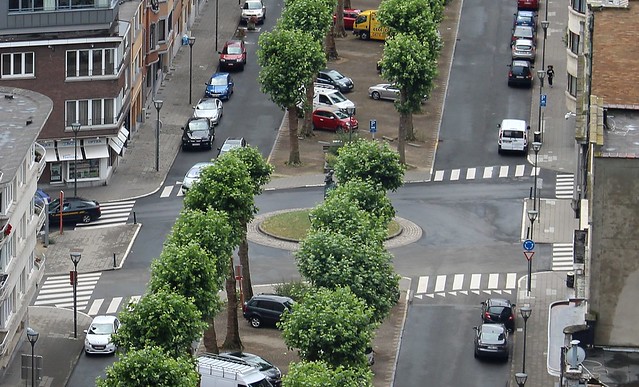
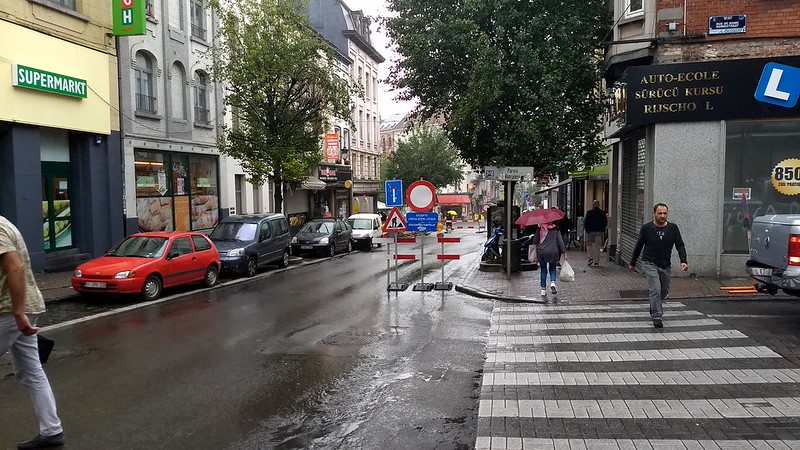
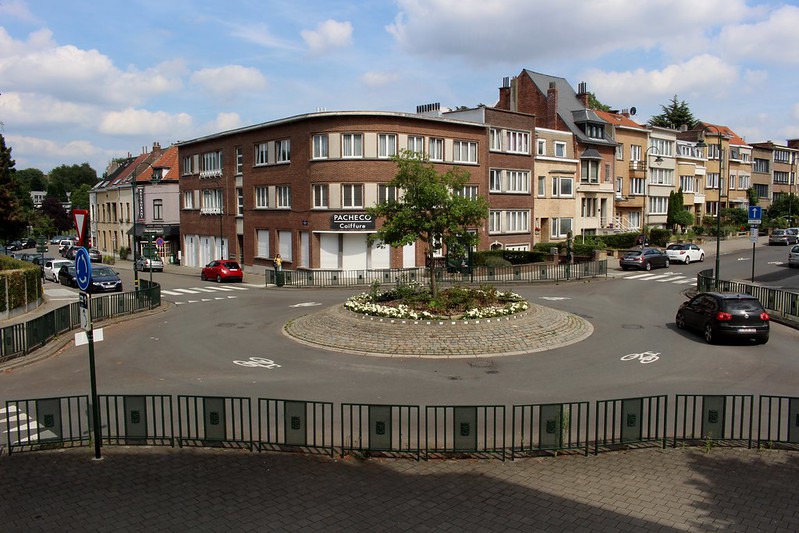
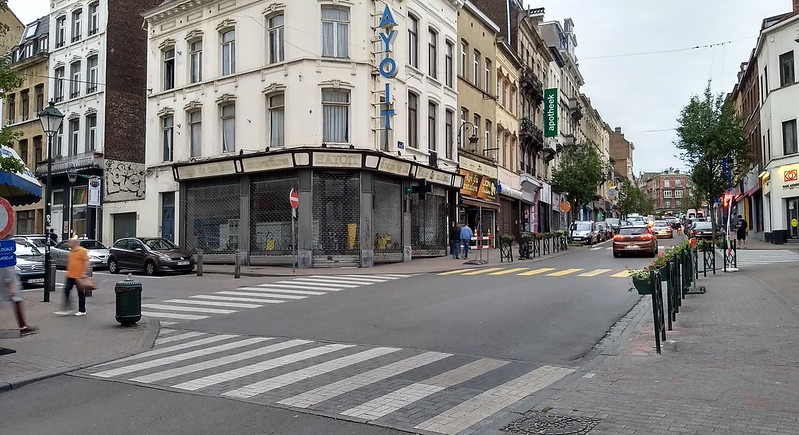
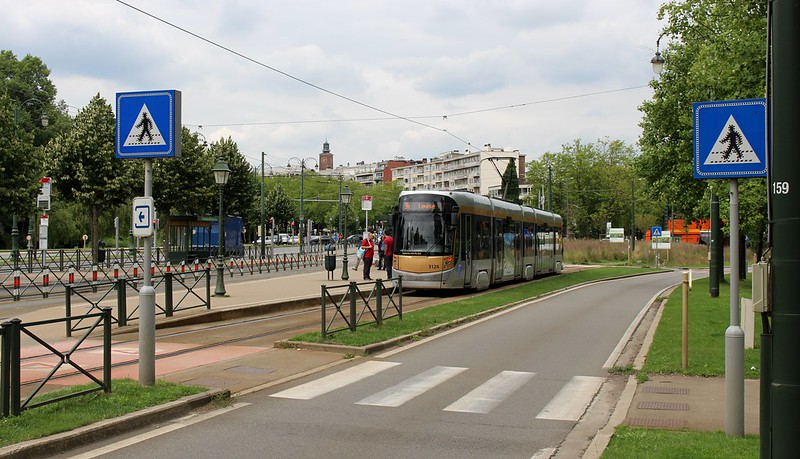
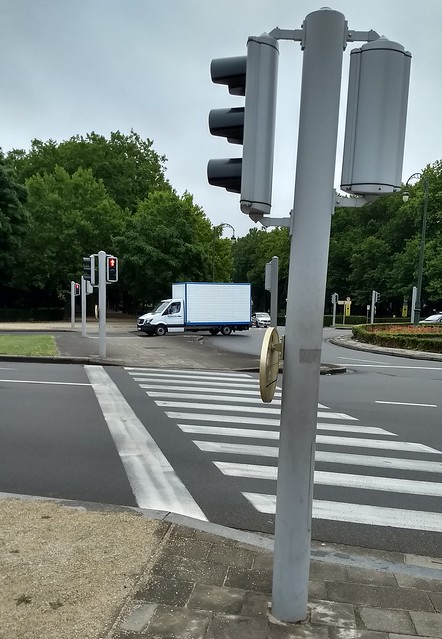
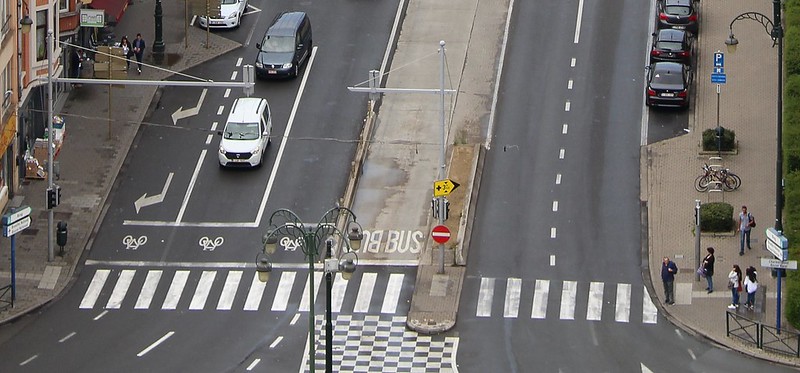

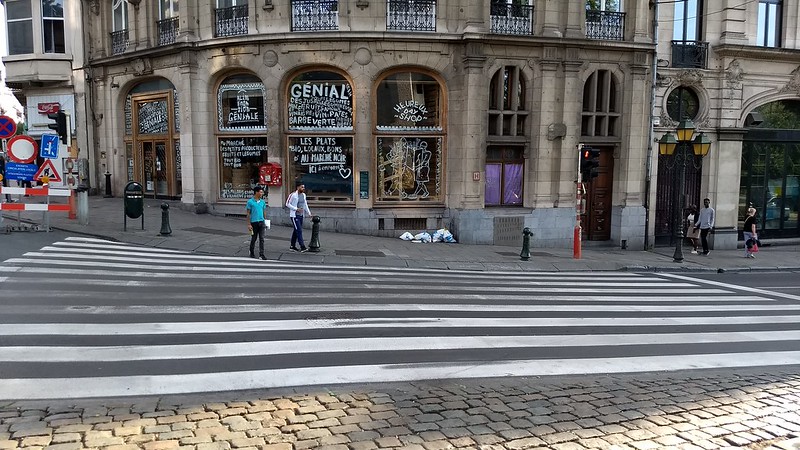
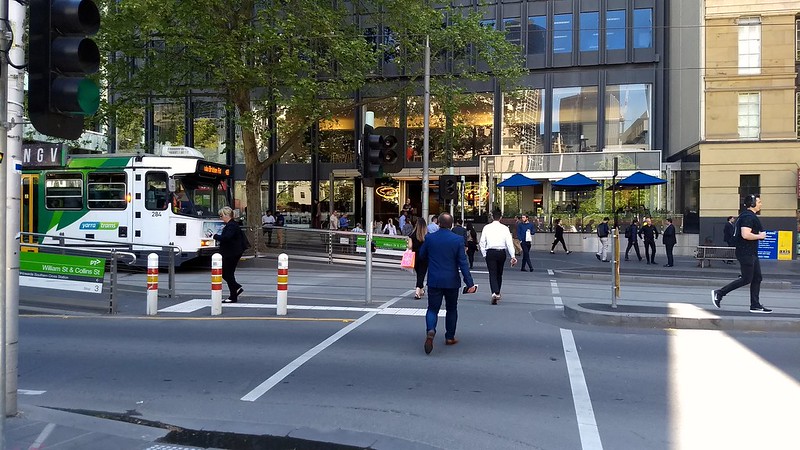
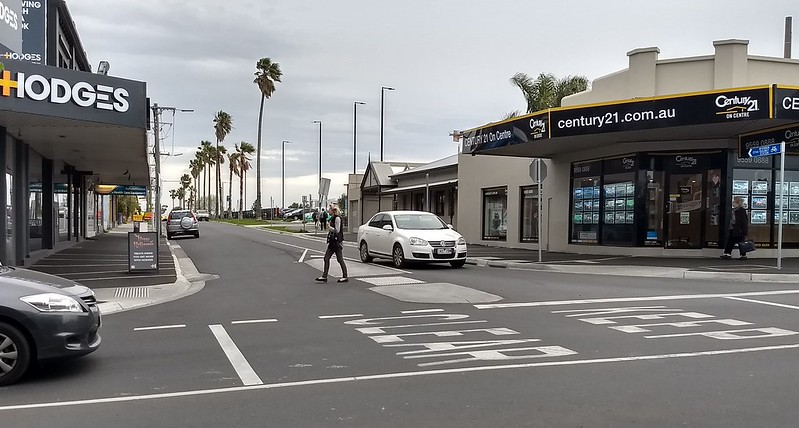
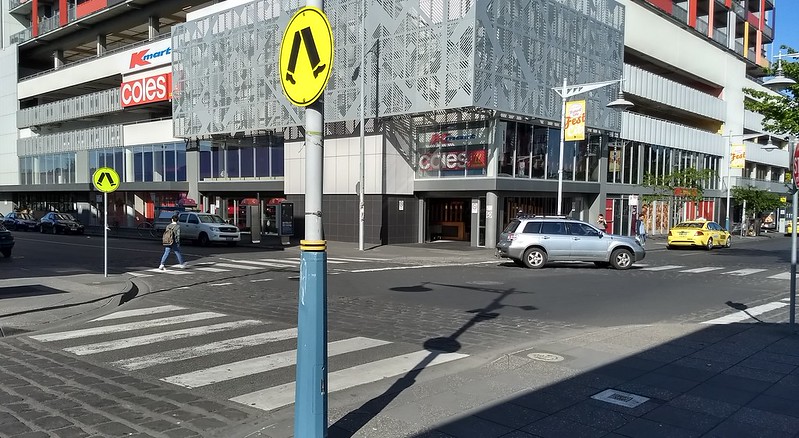
20 replies on “Brussels has zebra crossings. Lots and lots of zebra crossings. Could we have more too?”
There was a long time in the 1980s – 2000s when new subdivisions got roundabouts instead of traffic lights. That was fine when traffic was light but when they got built out crossing (and thus catching buses) became impossible/dangerous. There has been signalisation at some intersections in recent years but a large backlog remains. The mindset is that pedestrians are tolerated when there’s no cars around but as soon as car traffic levels grow their rights vanish (inducing car traffic for short trips as walking is unsafe).
If roundabouts are to precede lights in new areas, ALL of them should have zebra crossings on all directions. This introduces a different starting point. That is pedestrians have good access from day 1. Their ability to walk is not lessened as traffic levels rise. Zebra crossings may be replaced by lights but councils/governments holding off on this does not lessen pedestrian access (unlike now). New estates are great opportunities to experiment with this sort of thing (as people moving in are more open to change as they’re already making other changes) and the cost (a bit of paint), awareness campaigns and enforcement is negligible.
Not many cars use Paisley St in Footscray at the best of times – apart from the buses – so the zebras are fine in this one-way street.
The tram stops where zebras would be better than signals are those right down Collins St in Docklands – very little traffic at any time there, so no real point in activating and waiting for the lights.
I agree, there should be more zebra crossings. And more of the zebra crossing should be speed humps as well, such as north of Murrumbeena and Caulfield Stations, to increase compliance.
Vehicles facing stop and give way signs should be required to give way to all pedestrians.
What a fascinating study! I liked your pictures, too.
I think Melbourne has lots of pedestrian crossings at intersections (with red/green man) so they don’t need stripes on the ground. Motorists stop on the red light – adding stripes to the road probably doesn’t add anything. I’m not sure, however,.
I don’t see how putting speed bumps in the path of bus routes is a clever idea. There are other ways to slow down vehicles and wouldn’t it be better to spend the money on extra bus services.
@Peter, really great point – similarly, installing bus lanes and other PT priority early can help insulate services against traffic congestion as suburbs grow.
@Steve, if you’re saying that pedestrian amenity can only be improved if it doesn’t inconvenience car users (even in the CBD!), then I think you’ve missed the point. Authorities need to prioritise the modes they want used more.
@Roger, the issue is that motorists often do not stop at the stop line, and instead block the pedestrian crossing. See this post
Pedestrian crossing blocking is an issue (particularly, but nowhere near exclusively, for cars turning right, because of waiting in the intersection for a gap in oncoming traffic) that needs far more enforcement.
I agree that the crossings could be more clearly marked but I think there may well be good reason to have give way to pedestrian at all times zebra crossings differently marked than traffic light pedestrian crossings where the give way is only on turning into a road and they can be driven across without giving way during Green lights. Maybe paint traffic light pedestrian crossing yellow.
The French paint stripes as liberally as the Belgians do, but that doesn’t mean that Parisian drivers take any notice of them – you are a brave person indeed if you step out onto a pedestrian crossing in Paris without having made eye contact with any approaching drivers and ascertained that they are indeed slowing down.
Why do lights at road intersections even have buttons? As far as I can tell, the light cycle doesn’t change if the button has been pressed.
I have just been in Italy for 5 weeks, and though there are many zebra crossings around they are often extremely faded, they often end nowhere useful (e.g. up against a wall or fence as the existence of footpaths is irregular at best), and worst of all, the car and scooter drivers just ignore you unless you purposefully step onto the crossing – and even then they just zip closely around you. I ended up holding my hand up in a stop signal before I ventured out onto crossings.
We found the car drivers generally quite tolerant of cyclists but less so of pedestrians and had many hairy walks along roads with disappearing footpaths and non-existent shoulders. I wonder whether there is a high rate of pedestrian injuries and deaths – we saw many elderly people walking along narrow, windy roads who were squeezed into tiny spaces by the traffic – even one elderly lady who was forced to climb onto a barrier at the edge of a road as our bus whizzed right past her. Add all this to the cobblestones, potholes, uneven surfaces, huge recycling bins everywhere, cars and scooters parked everywhere and anywhere, and masses of road and footpath works that seem to have halted midway – and it is a nightmare for pedestrians. You certainly learn to keep your wits about you!
It’s strange that if you go over the speed limit, drink more than .05, run a red light, use a mobile phone while driving you pay a steep fine and lose points and apart from mobile phone use it seems to significantly reduced these undesirable behaviours. In scenarios were cars have to give way to pedestrians at zebra crossings there is little enforcement and education, the same situation occurs when cars block intersections in the CBD and other busy roads as well as cars driving menacingly towards pedestrians at T intersections where pedestrians have the right of way.
In the local area there was a zebra crossing and they changed it to a signalised one as many drivers ignored it and only payed attention to red lights.
It’s not as bad as Italy and pretty much the rest of the world except Northern Europe however many pedestrians recently arrived from Asia stop at intersections where they have priority which is frustrating as a motorist because you stop anyway and have to wait for them while they are confused.
” At many of these, you didn’t have to press a “beg” button – there was no button. ”
In Australia, this violates the DDA regulations. The button themselves provide a tactile indication of the direction it applies to, and pulsates (as well as makes an audible noise).
But I also note from all the pictures in Brussels that there are very few tactiles on any of the crossings shown.
Zebra crossings, are inherently more dangerous and intimidating than traffic lights.
Zebra crossings depend so much on the ability to get eye contact between the pedestrian and the motorist. Most of the time, I can not even see the driver. All it takes is, a little bit more tinting, and/or the sun to be on a particular angle, and all visibility into the car is gone.
The number of close calls I have had at Zebra crossings is great. Not so with traffic lights.
Lots of zebra crossings in the docklands, Collin St and Harbour Esplanade.
Unfortunately they don’t work because far too many drivers don’t know they have to give way sadly.
Quite frankly, I’m sick of looking out of my office at the intersection below to see 100+ pedestrians squeeze into intersection corners and having to wait 2 minutes for a green light to cross the road while 10 odd single occupant cars get a priority run through.
“You might not be in any great hurry to get where you’re going, but you don’t speak for everybody else.”
And neither do you. In a zoo like Bentleigh, where you’re just as likely to get clobbered by “large” traffic turning into a legally crossing pedestrian, I’ll gladly wave them on and preserve my life a little longer. But next time I’ll check to make sure I’m not holding you up (unlikely – I walk faster!).
Taking my son to school at Oakleigh South, it is truly amazing how many cars drive through the red light at the pedestrian crossing on Centre Road (in front of the newly opened Star Track/Auspost depot). The recent employment of a crossing guard has done nothing to alleviate this. You honestly believe increased zebra crossings would be helpful in Melbourne?
My memory of being a pedestrian in Belgium … the bicycles. Lots of near misses.
@Thede3jay, thanks, that’s interesting. That obviously explains why even CBD crossings with 24/7 automatic green man will have a button.
@mizone, I haven’t walked around those parts of Docklands much, but my sense is the motorists will stop if the pedestrians are assertive enough to be clear about their intent to cross. Of course, finding the balance (eg not getting yourself killed) means you have to be prepared to move out of the way if a motorist insists.
@goober, I can understand your caution, but in case I wasn’t clear, I was talking about when the motorist has already stopped. You can wait if you like.
As far as motorists obeying zebra crossing rules, as I alluded to in the post, I think part of the problem is there’s not enough zebra crossings.
Daniel, my earlier comment was more related to today’s post on traffic lights, I think. Traffic signals that instantly react to pedestrians, rather than causing them to wait, will mean people might be more inclined to use them, rather than looking to see there are no cars coming and then walking. In some cases that might be preferable to zebras, but the outcome is the same – prioritising pedestrians where it makes sense.
In Sydney most of the pedestrian crossings across main roads were either signalized or removed years ago.
It was rather disconcerting to start visiting China a few years ago, where they have unsignalised crossings across six-lane roads mid-block, and the cars actually stop. I remember standing on the kerb waiting for the traffic lights at the big corner 600 metres down the road to cause a break in the traffic, and then realise that all the cars right where I was, were waiting for me to start crossing.
On a more recent visit to the same spot, I noticed that they had put in a signal to make the pedestrians wait – a very long time – It is not an improvement.
There definitely should be more unsignalised pedestrian crossings for pedestrians where there are many minor roads joining a less minor road. It should be possible for a pedestrian to walk along a local main road without risking being run over every 100 metres by vehicles turning in and out of side streets, and without waiting 90 seconds for a light, either.
@daniel
Yes Daniel, you are right, pedestrians need to be assertive. The thing is, instead of treating zebras like a give way (ie. slow down, check), they just drive through at normal speed until having to brake at last second, because of this, can you blame pedestrians for not wanting to be assertive?
On Collins st its okay, because of how many people stream out of the station and trams, there will always be one pedestrian to stop traffic and “lead the way”. But on harbour esplanade, its usually only one pedestrian at a time so they don’t work as well.
Then there is always a pedestrian that will not cross and give way to cars… this concerns me most, as they might also be the driver that doesn’t know that zebra means cars give way.
*sorry for the rant, but I work in Docklands overlooking a busy corner from my desk, witnessing all this every single second, and am just disappointed for a new area that they have somehow not given a single thought to pedestrian priority.
Seeing Gardiner station’s should-be-a-crossing-but-isn’t reminds me of examples closer to home.
I remember when Carrington Rd in Box Hill was upgraded in the 1990s, new pavements reflecting the Chinese/East-Asian flavour of the area. The speed calming (not quite elevated pavements) weren’t crossings, but people were treating them as crossings, despite signage saying “Pedestrians must give way to cars”. I remember someone wrote to the local Leader about the cars not stopping. I wrote a reply saying there were signs. Problem is, the signs were about 6 feet off the ground… and most of the locals were much shorter than that, and didn’t read them. Eventually the signs were removed, and the pavers, and asphalted zebra crossings installed. Pedestrians won.
Jackson Court in Doncaster East had crossing points with waist-high poles and signs reading “Pedestrians must give way to cars”, back when I first started going there in the early 2000s… after the Safeway closed and Dan Murphy opened, a few upgrades to parking occurred. At the same time, Manningham chose to replace the pedestrian-wait crossings to proper zebras. Another win for pedestrians.
An older example… as a kid I remember the zebra crossing on Station St, Box Hill linking Main St and Bank St. This was replaced with a pedestrian underpass when Box Hill Central was built. Unfortunately people decided to keep crossing at ground level for the next 15 years… dunno if it made them get to Timezone or Club X quicker, or if people increasingly were using the underpass as a urinal.